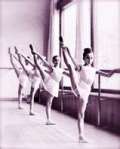 With the new dance season coming just around the corner, I thought it would be a great time to discuss how to locate a good dance school…….
With the new dance season coming just around the corner, I thought it would be a great time to discuss how to locate a good dance school…….
The first step to finding the right dance school for you is discovering what you truly want to do with dance in your life. Realize what your goals, dreams and desires are in respect to dance. Do you just want some exercise? Do you just want a social activity? If your focus is purely social and a little exercise, then your journey is much more easier than you thought. Just ask around.
But, if you absolutely love to dance —if you eat, think, sleep and dream dance — and have the thoughts of a professional career, either on stage, as a teacher or choreographer, then your goal is to find a school with teachers who have a focus on those same ideals. A teacher who has your dreams in their heart as well.
Once you know what kind of a dance school you are looking for, it will be much easier to find it. First, talk with the owner of the school. Do the teachers who work for the school have some type of certification or are on their way to one? What kind of experience do the teachers have? Where did they study? Don’t just be impressed with rows of trophies, since to be judged is always just someone’s opinion. Not all schools with rows of trophies have the dancer’s heart first and foremost in their value.
One thing to think about is dress code. Dress codes have multiple benefits for dancers in a class. Not only do dress codes create uniformity and unity among dancers, it helps in teaching students the beginning basics of discipline and “dressing the part’” that is so important as a dancer. When dancers wear the same attire, it minimizes distractions for students and creates an atmosphere of focus and energy. Dress codes are also extremely important in helping instructors see mistakes in a student’s technique and body positioning, therefore allowing for better corrections and education. Dress codes are a form of “dancer discipline”. Is discipline a part of the school’s criteria? It should be. Dance is discipline.
Well rounded dance programs should offer an array of classes with the main focus on classical ballet and ballet technique with possibilities of pointe work in the future. Jazz, tap and modern should be second on the list of classes to search out. All of these classes contribute to the building of a well rounded, well informed dancer.
Does the school offer a graded syllabus where the dancer will progress to a certain level from year to year? This is an important question to ask. Just as you would graduate from grade to grade in school the same should be for dance school.
Does the school know what method of ballet that they offer. You would be surprised that some local dance schools have no idea that there are different methods or the differences between them. I teach the Cecchetti method, but some of the others that are foremost are the Russian Vaganova method and the Royal Academy of Dance method. We will discuss their differences in a future post. It is good for a school to focus one method instead of combining methods as many do. The variations in the syllabus and the technique can confuse a dance student.
Are you interested in an end of the year performance? Are you interested in dancing in a Nutcracker at Christmas time? Although these two aspects of dance school are important for learning stage presence they should not be the focal point of the studio, learning and increasing your dance technique should be the main objective.
Some signs of quality dance training are:
-Proper placement in class and focus on correct fundamentals
-Emphasis on correct execution of steps, with focus on clean lines, strength and stability,.
-Technical proficiency of a majority of students in the school. -Graduating dancers with intent to continue dance.
I am hoping that this dance season will be your best one ever, learning good solid technique, gaining strength, progressing and having fun!